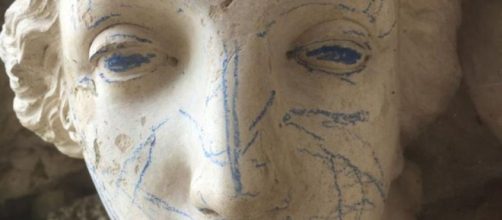Magic happened in the art world last week, although I may be the only one who viewed it that way.
A 230-year-old stone statue of the ancient Roman water nymph Sabrina was vandalized in Worcestershire, western England. The perpetrator marked up her arms, torso and face with a bright blue crayon.
Conservators were able to remove the defacing. But while it lasted, something remarkable went unnoticed and certainly unintended by the sculptor John Bacon.
Life after death
The blue lines had the look of a venous system, a network of vessels of blood coursing through the stonework.
And in that way, Sabrina came alive.
Do I hear a “so what?” Granted, nymphs were not goddesses. They were minor deities and not immortal like goddesses. But with streaks of blue, this two-century-old statue became a living creature.
So, when a spokesperson for the British conservation charity National Trust said in a statement that the violation was “upsetting,” because the statue couldn’t be fully appreciated, I didn’t agree.
According to Art News magazine, the lack of appreciation is not the result of vandalism, it’s the cause of it. In a 1987 report, the magazine concluded that art vandals are ordinary people expressing their anger at being excluded from the elite world of cultured activity.
The magazine was referring to abstract art. It’s not yet known why “Sabrina” was marred with crayon, but whatever impelled the vandal to act, the naturalism of the statue couldn’t have posed a cognitive problem. As for despoiling recognizable art, Art News said that’s an act of an unbalanced mind.
But wait. An argument can be made that the vandal who marked Bacon’s statue up with blue crayon was not unbalanced.
After all, he or she could have used any color crayon, say red or black. Choosing blue seems significant.
Is it possible that the vandal sought the look of a venous system to give the stonework life?
I grant you my reaction to scrawls on “Sabrina” is not appropriate. With apologies to John Bacon, the scrawls seemed to give it a life it didn’t have.
Touch of Venus
The phenomenon calls to mind the window dresser awakening a manikin with a kiss in the 1948 fantasy film “A Touch of Venus.”
Of course, Bacon wouldn’t like what I’m saying any more than Frederick Hartman liked it when Warner Bros. Studio animated a replica of his sculpture “Ex Nihilo,” the story of Genesis, fronting Washington National Cathedral for the 1997 movie “The Devil’s Advocate.”
Hartman was so upset by the enlivening that he asked the movie studio to stop distributing the film. He had a point. Unlike Bacon’s “Sabrina,” the manipulation of the story of Genesis changed its meaning.
The sculpture by Hartman depicted creation with male and female nudes coming into being. The movie, starring Al Pacino as Satan, shows the same figures committing wanton sexual acts.
Obviously, Warner Bros. twisted the meaning in Hart's sculpture from divine to demonic. But no such twisting can be ascribed to the marring of “Sabrina.” If anything, the meaning was enhanced.
Talk about enhancing an artwork by disfiguring it, in 1999 a pair of performance artists acted out on Tracy Emin’s sculpture “My Bed” in an act they called “Two Naked Men Jumping on Tracy’s Bed.” A verifiable enhancement if there ever was one.


